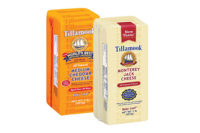
Although the economy has seen brighter days, Chicago-based Mintel International says the cheese forecast for 2009 is favorable and expects the market to grow 23% from 2009 to 2013. That’s in addition to the category’s 15% rise in sales over the past three years, according to Mintel’s executive summary conducted in May.

Natural cheese success derives from the consumers’ desire to eat more premium, healthy products, the report says. Shoppers want better-quality foods without the premium-infused price.
That’s why today’s cheesemakers are producing a slew of authentic new products, complete with healthy labels, convenient packaging and a price point shoppers can’t pass up.

Cheese with a kick
Whether it’s sliced, diced or cubed, cheese is always a tasty addition to an otherwise mundane meal, salad or cracker, especially when the cheese itself delivers a kick to the mouth.Take Yancey’s Fancy, for example. The Corfu, N.Y.-based cheesemaker developed a handful of spicy cheeses, such as the Mild Buffalo Wing Cheddar & Blue Cheese variety, which combines blue cheese and aged cheddar with buffalo wing sauce to add a spicy kick to nachos, chili or omelets. The Aged Cheddar with Buffalo Wing Hot Sauce option blends aged cheddar with habañero, jalapeño and cayenne peppers, the maker suggests a pairing with a strong beer, semi-dry Riesling or a glass of bold red wine. And the N.Y. Maple Cheddar cheese consists of a combination of maple syrup and sharp and mild cheddar cheese, recommended for sandwiches or piled on top of croissants, bagels or biscuits.

Inspired by ethnic cuisines and authentic Latin ingredients is Artisan Blends Authentic Mexican cheese, produced by Sargento Foods, which combines El Regalo Manchego, a sweet and nutty cheese, with Anejo Enchilado, a pressed cheese that’s rolled in paprika, along with Sargento Queso Quesadilla, Asadero and Queso Gallego cheeses.

“Convenience never seems to lessen as a driver in consumer considerations, so we added line extensions to our Salad Finishers and Potato Finishers to turn ordinary lettuce and potatoes into restaurant-quality meals at home,” says Barbara Gannon, Sargento’s vice president of corporate communications and government relations.

“As consumers’ palates are becoming more sophisticated, they will continue to look for new, unique, full-flavored cheeses,” he says. “Convenience will continue to affect the cheese category. For everyday use, consumers will want to see more of a selection of cheeses in pre-sliced and pre-shredded varieties.”
In addition to its aged cheddars, Tillamook’s flavored cheese line includes Smoked Black Pepper White Cheddar, Garlic Chili Pepper Cheddar and Garlic White Cheddar, Allison notes.

Sliced to perfection
Nearly 80% of cheese consumption is done through sandwiches or other foods that contain cheese, Mintel reports. That’s why today’s cheesemakers are expanding their product offerings to include pre-sliced cheeses that are available in the dairy aisle and at the deli counter.Applegate Farms launched its first set of bulk deli cheeses in Provolone, Swiss, American and Medium Cheddar varieties, marketed as being produced with milk from cows not treated with rBGH. Meanwhile, its Sliced Organic American and Provolone offerings join an array of already pre-sliced cheeses.
“Our pre-sliced Provolone, Swiss and Cheddar are the top-selling cheese products at Applegate Farms,” says Gina Asoudegan, manager of communications and outreach for the Bridgewater, N.J.-based company. “In addition, consumers are interested in functional foods, such as cheese containing probiotics. Last year we launched pre-sliced yogurt cheese with probiotics in response to consumer demand for this type of product.”

“If you look at restaurant menu trends, robust cheese flavors are the hero. Consumers are seeking taste adventures through new experiences,” says Mark Korsmeyer, president of Dairy Food Products at Kansas City, Mo.-based Dairy Farmers of America, which makes cheese sold under the Borden brand.
On the other hand, St. Paul, Minn.-based Land O’Lakes introduced 2% Milk American Deli Cheese, which delivers 25% less fat than regular American deli cheese. According to a press release, retailers receive the cheese in 5-pound blocks, which can be sliced out to consumers at the deli counter.

Organic goes home
Aside from spicy cheeses with distinctive attributes, Mintel reports a downturn in all-natural and organic claims for new products within the past year. Typically sold at premium prices, organic products have been at the mercy of consumers looking to save money in a struggling economy.“While this doesn’t suggest directly that natural products are losing favor with consumers, as existing products could be performing quite well, it does point to possible market saturation with the sheer number of all-natural and organic products that the market can bear,” the report says.
Plus, several cheesemakers are revamping their processes instead of developing new products to stay on par with rBGH-free production.
“There has been a push for ‘hormone-free’ cows when purchasing dairy products, which we have moved to completely,” Wimble says. “We [also] now make use of our whey for many different options, for pig farmers, etc. We’ve also established a lock-in price with our farmers to help protect them financially.”

“The biggest challenges our customers face with natural and organic cheese and deli meats are educating consumers about claims such as rBGH-free, natural and organic,” Asoudegan says.
However, the production of organic cheeses isn’t dead yet.
Organic Valley, La Farge, Wis., developed Vermont Cheddar cheese in Medium, Sharp and Extra-Sharp varieties. These 1-pound blocks of cheese are white cheddars made with non-GMO animal rennet and come from 60 local family farmers.

Long journey ahead
Despite Mintel’s positive figures, some companies are still a bit wary in how business will eventually pan out and understand that it’s a long road ahead, filled with challenges, competition and the desire to stand out.“2009 has been a good year despite the challenges in the economy,” Gannon says. “We are carefully monitoring government policies, which could negatively impact profitability of cheese and business in general.”
For starters, many U.S. cheesemakers compete not only with other U.S. companies, but are now beginning to work against international ones as well.
“We see U.S. demand for dairy products continuing to slowly increase and international demand to do the same, but international demand to increase later in the year. Worldwide milk production will be tighter as dairy farmers globally are in the same ‘margin squeeze’ situation as here in the U.S. As world economies recover dairy demand will pick up,” Korsmeyer says. “As a dairy foods manufacturer, we need to maintain a low cost of goods to remain competitive with our customers. As an industry, we face volatility with commodity pricing and rising energy costs.”

“Space management is always a challenge for retailers,” Gannon adds. “We are helping them by demonstrating with data that the natural cheese category is most profitable for them.”
Meanwhile, price structures are built into retail costs, which make it difficult to purchase items at an affordable price, Wimble says.
“We’ve been moving to offer smaller items at a lower cost to increase their options,” he says. “There are also larger items sold out of stores such as Costco, which we can sell at a discounted price.
In addition, words like volatility continue to be a key buzzword in the cheese category, Allison says.
“The highs and lows of the markets have caused very difficult times for cheese manufacturers,” he adds. “We are optimistic about the future. We are hopeful the factors that contribute to dairy pricing will level off a bit in the near future in order to allow our farmer-owners to make a living as well as us to manufacture cheese at a competitive price.”
To stay on trend, and in the consumer limelight, today’s cheesemakers must continue to develop exclusive new products that deliver an abundance of flavor and spice – and everything that’s nice.
Fast Facts
Source: Mintel
Links
- State of the Industry 2009: Beverages -- Fusion of Flavors
- State of the Industry 2009: Butter--Spreading It Thin
- State of the Industry 2009: Ice Cream--Chilling Effect?
- State of the Industry 2009: Ingredients--Ingredients With Purpose
- State of the Industry 2009: Milk--Flowing Downhill
- State of the Industry 2009: Yogurt -- It's Alive
- State of the Industry 2009: Introduction
- State of the Industry 2009: As the World Turns (Global Report)

